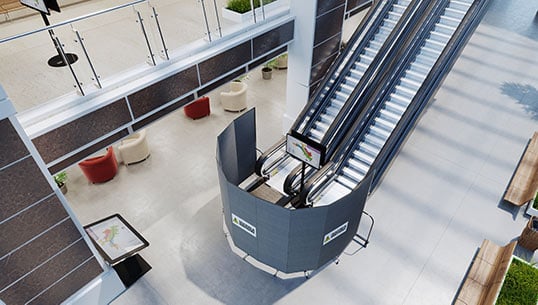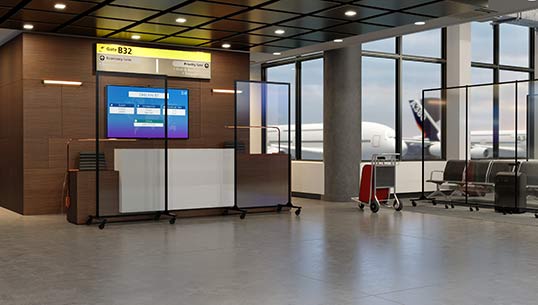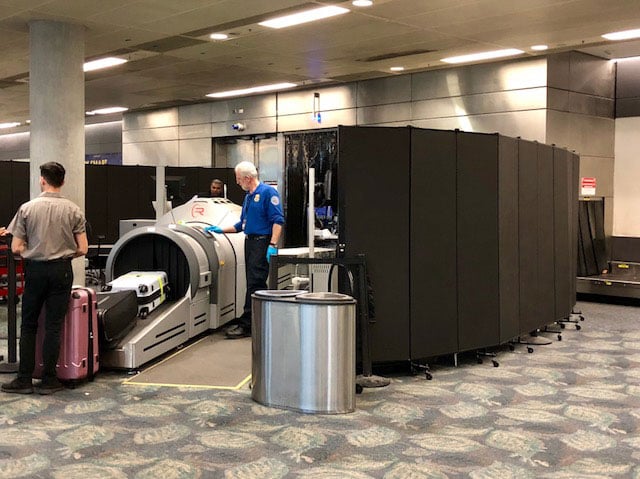3 Ways Dividers Create Airport Safety
Market: Government Purchasing
Just before the Pandemic of 2020, travel was on the rise every single year. In 2018, there was a recorded 1.3 Billion international travelers. This total grew by 6% from the previous year. From business to vacations, it has never been easier to jump from city to city. Since airports have had to deal with this increase in popularity, they’ve also had to learn how to manage the additional foot traffic. The general rule of thumb when it comes to crowds of people in a facility is to expect the unexpected. By having portable room dividers at the ready, airport officials can maximize their space for excellent crowd control and safety directing.
Temporary Closures
- Escalators/Moving Sidewalks. Sometimes technology breaks down. How many times have we seen an escalator stop working in a mall, airport, or hotel? Just like any moving thing, it requires maintenance. When the escalator or moving sidewalk needs repair, the airport staff shut it down and block it off so people don’t get in the way or get hurt. Using a portable room divider, the surrounding entrances of the escalator can be barricaded to prevent people from coming in. When the repairs are over with, the dividers easily fold up and glide over any surface.

- Gates or Restricted Areas. In the case of a biohazard or repairs on or near the gate entrance, safety barriers can help restrict access. Since the gate’s seating area can be a variety of different lengths, a long divider is the best option. Screenflex offers some airport safety dividers that are just over 24′ in length. Combining these portable partitions with a shorter one could easily cover any extra distance. There is still airflow underneath and on top of the divider too, so employees working in the enclosed area won’t feel as stuffy or hot.
Protective Germ Barriers
- Check-in. Since thousands of people pass through an airport on any given day, it can be an incubator of germs and infectious diseases. Especially in current times like the Pandemic, clear plexiglass barriers have become essential in just about any public place. An excellent location for these barriers is when people arrive right at check-in. Having a plexiglass barrier can help airport staff and passengers prevent their germs from spreading to one another.
- Boarding Gates. Other locations where there are a high number of passenger/staff interactions are the boarding gates. Using a clear plexiglass divider can help limit the germs passing through the air. Since boarding passes are scanned at the gate entrance, passengers will likely have to hold their boarding pass up to the acrylic barrier instead of handing it to the airport staff. The barcode should still quickly scan and not cause a major hold up.

- Vendors/ Restaurants. The last but not least area to put a clear barrier are all of the restaurants and vendors the airport holds. This part of an airport likely has the most physical contact as both money and food items are exchanged back and forth. For this purpose, use hanging plexiglass sheets instead of floor-length dividers to exchange goods and commerce easily.
Crowd Control/ Traffic Directing
- TSA Checkpoint. As we have all seen, airports can get crowded, especially at the TSA Checkpoint. Most of the time, there are rope barriers to help guide foot traffic and compress the length of the line. Room Dividers can also help with crowd control in these areas for a more private and sturdy base. Near the body scanner/x-ray machine especially needs the extra durability that room dividers provide since so many people pass through it. These partitions also can be used for a private security screening area as well.
Crowds need directing when in large quantities. For safety reasons, it’s better to prevent panic and other potential issues. By using flexible and portable room dividers, you can transform and maximize your airport space traffic and safety.

